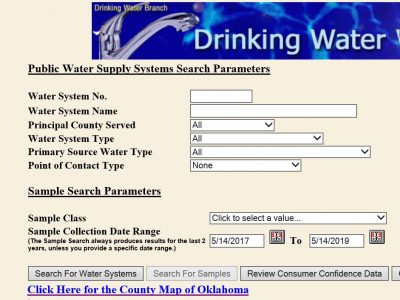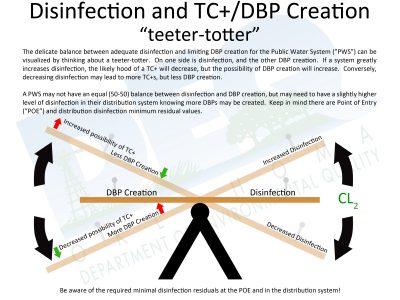Drinking Water Compliance Monitoring
 Find Out About Your Drinking Water
Find Out About Your Drinking Water
The first step in ensuring safe drinking water requires testing to ensure the water provided meets applicable standards.
Visit Drinking Water Watch to see analytical results, monitoring requirements and violations to learn more about the quality of your drinking water.
- Drinking Water Watch
- Instructions for Drinking Water Watch
Drinking Water Rules
The purpose of the Revised Total Coliform Rule (RTCR) is to increase public health protection through the reduction of potential pathways for microbial contamination to enter distribution systems and to better protect the public from waterborne illness. The purpose of the Ground Water Rule (GWR) is to reduce disease incidence associated with harmful microorganisms in drinking water.
For more information regarding the Revised Total Coliform Rule, please visit EPA’s webpage.
For more information regarding the Ground Water Rule, please visit EPA’s webpage.
For specific rule information and your PWS Contact PWS Compliance.
The purpose of the lead and copper rule is to protect public health by minimizing lead and copper levels in drinking water. Because lead and copper in drinking water is mainly due to the corrosion of service lines and household plumbing, tap water samples are collected at kitchen or bathroom taps of residence and other buildings. Public health benefits include;
- Reduction in risk of lead exposure, which can cause damage to the brain, red blood cells and kidneys, especially for young children.
- Reduction in risk of copper exposure, which can cause stomach and intestinal distress, liver and kidney damage.
Lead and copper enter drinking water primarily through plumbing materials. EPA established the Lead and Copper Rule to monitor drinking water at customer taps. If lead or copper action levels are exceeded in more than 10% of customer taps sampled, the system must undertake corrective actions to control corrosion.
For more information regarding the Lead and Copper Rule, please visit EPA’s webpage.
For specific rule information and your PWS; like
-
- homeowner sampling instructions,
- EPA’s 3 Ts for sampling in public schools guidance documents,
- public water system Sample Site Request forms,
- Consumer Notices of Lead Tap Results templates, and
- Optimal Corrosion Control Treatment Recommendation form Contact PWS Compliance.
The purpose of the rule is to reduce exposure to disinfection byproducts. The rule applies to community and non-transient non-community systems that add or have a disinfectant in their drinking water.
The most common regulated contaminants in this rule are Trihalomethanes (TTHM) and Haloacetic acids (HAA5).
For more information regarding the Stage 1 and Stage 2 Disinfectants and Disinfection Byproducts Rules, please visit EPA's webpage.
For specific rule information and your PWS Contact PWS Compliance.
Operational Evaluation Level (OEL) Reporting Forms
The delicate balance between adequate disinfection and limiting disinfection by-product (DBP) creation for the Public Water System (PWS) can be visualized by thinking about a teeter-totter. On one side is disinfection, and the other DBP creation. If a system greatly increases disinfection, the likely hood of a TC+ will decrease, but the possibility of DBP creation will increase. Conversely, decreasing disinfection may lead to more TC+s, but less DBP creation.
A PWS may not have an equal (50-50) balance between disinfection and DBP creation, but may need to have a slightly higher level of disinfection in their distribution system knowing more DBPs may be created. Keep in mind there are Point of Entry (POE) and distribution disinfection minimum residual values.
Be aware of the required minimal disinfection residuals at the POE and in the distribution system!

The purpose of the Surface Water Treatment Rules (SWTRs) is to reduce illnesses caused by pathogens in drinking water. The disease-causing pathogens include Legionella, Giardia lamblia, and Cryptosporidium.
The regulations provide protection from disease-causing pathogens and also protect against contaminants that can form during drinking water treatment.
Rule Summary
- Applies to all public water systems (PWSs) using surface water sources or ground water sources under the direct influence of surface water (GWUDI)
- Requires most water systems to filter and disinfect water from surface water sources or GWUDI sources
- Establishes maximum contaminant level goals (MCLGs) for viruses, bacteria and Giardia lamblia
For more information regarding the Surface Water Treatment Rules, please visit EPA’s webpage.
For specific rule information and your PWS Contact PWS Compliance.
The Phase II/V Rules contain monitoring requirements and maximum contaminant levels for 13 inorganic chemicals (IOCs), 21 volatile organic chemicals (VOCs), and 29 synthetic organic chemicals (SOCs). Waivers are available to water systems to reduce or eliminate the number of samples a system must take while not jeopardizing public health.
What Types of Contaminants are These?
IOCs are chemical substances of mineral origin. These include metals such as mercury, chromium, nitrate and arsenic.
VOCs are chemicals that are used and produced in the manufacture of paints, adhesives, petroleum products, pharmaceuticals, and refrigerants. They often are compounds of fuels, solvents, hydraulic fluids, paint thinners, and dry-cleaning agents.
SOCs are manmade compounds commonly used in herbicides and pesticides.
For more information regarding the Chemical Contaminant Rule, please visit EPA’s webpage.
For specific rule information and your PWS Contact PWS Compliance.
The Consumer Confidence Report (CCR) is a document community water systems are required to provide annually to its customers. The CCR provides consumers information about the quality of their local drinking water. The CCR summarizes the previous calendar years data that the water system already collects to comply with federal and state regulations. It includes information about the source(s) of water, chemical contaminants, bacteriological contaminants, compliance with drinking water rules, educational health information, and water system contact information.
For more information regarding the Consumer Confidence Rule, please visit EPA’s webpage.
Video Tutorial for Completing your CCR
For specific rule information and your PWS Contact PWS Compliance.
The public notification rule ensures that consumers will know if there is a problem with their drinking water. Public notices explain the severity of the problem and what actions need to be taken.
For more information regarding the Public Notice Rule, please visit EPA’s webpage.
For specific rule information and your PWS Contact PWS Compliance.
For a video tutorial on completing your Consumer Confidence Report, visit our CCR Tutorial Page.
Useful Information for Collecting Drinking Water Samples
Useful Information for Certified Laboratories Reporting Samples and Results
Reports and Other Helpful Information
- 2017 Annual Compliance Report
- 2018 Annual Compliance Report
- 2019 Annual Compliance Report: Executive Summary for EPA – Full Report
- 2020 Annual Compliance Report: Executive Summary for EPA – Full Report
- 2021 Annual Compliance Report: Executive Summary for EPA – Full Report
- 2022 Annual Compliance Report: Executive Summary for EPA – Full Report

